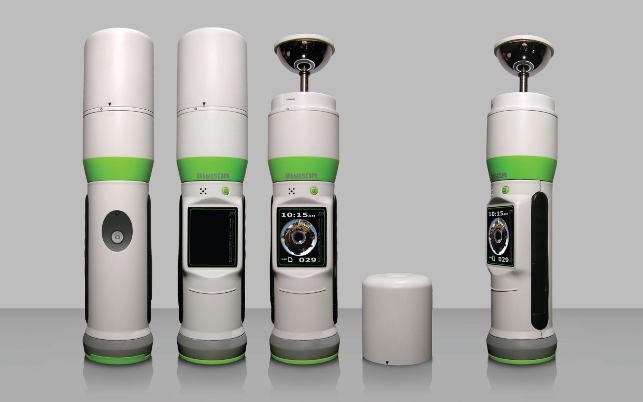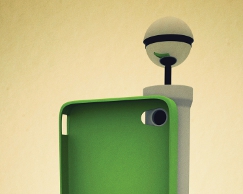Many of us have experienced a moment in our lives that we’d love to capture. Not just a photo of a single scene but a full 360° panorama.

Early development of the BubbleScope 360°
This is exactly what Tom Lawton experienced in 2001 whilst on a 56 hour train journey in India. Through an open doorway he witnessed a spectacular scene as the sun set behind the distant mountains.
He wanted to freeze time in every direction — like a bubble. “I imagined being able to shoot the bubble instantly and in that moment share it with someone somewhere else,” he explains. The seed for the BubbleScope was sown.
A product design and visualisation graduate of Bournemouth University, Lawton enjoyed success very early on in his career. He turned his final year university project — the WakeYoo recordable alarm clock — into a commercial reality in 2000 and it went on to sell over 250,000 units.
This set Lawton off on an invention path that has seen him bring a number of products to market, such as Firewinder, an outdoor light solution powered entirely by the wind and Lockdown, a portable outdoor stash-box.
Others are still in prototype form at his Wiltshire-based design studio and many are still bouncing around in his head.
“My son’s toys are often bereft of crucial features that I have hacked and transformed into something else. Even my push bike has a skateboard welded to it so that I can take him to school without needing to use a car,” he smiles.
“I live and breathe new ideas. I don’t read — I buy blank sketchbooks and fill them.”
Thought bubble
Following his trip in India in 2001, Lawton set upon a self initiated R&D project to develop a compact and affordable instant 360° imaging device that could capture bubbles in a single click.
His vision was to have it interface with a mobile phone or computer so that it was possible to instantly share the moment (this was of course before the advent of smartphones with their in-built cameras).
He had certainly set himself a challenge as he admitted that he knew nothing about designing camera systems or the dark art of optical physics. “But that’s a perfect project for me — just dive straight into the deep end of an unknown subject that I have a growing passion in,” he says.
“I also like finding experts and have found that they are far more forthcoming with answers when you’re clueless — it’s the opposite of being threatening.”
For the next two years Lawton carried out extensive research.
Following some feasibility studies with the help of the precision optical design division at BAE Systems, Lawton realised that capturing a 360° image with a single optical system would require a complex and expensive solution.
Without hundreds of thousands of pounds to inject into researching and developing his own technology he chose to adapt a proven technique.
He formed a strategic relationship with a Canadian technology company in 2004 which licensed its patent for a toroidal reflector. Together they managed to miniaturise the technology and create a mini omni-directional camera system.
“It worked, but optics are like windows — the bigger the window, the more light and the smaller the window, the less light,” he explains. “In miniaturising the technology we’d had to exponentially improve the surface quality of the mirror to keep the imaging quality.
This is easy to prove when a diamond is turning one of the mirrors at $6,000 each for a prototype but far more difficult to achieve when manufacturing for a system that has to retail for under $100.”
Funding your own R&D is one of the disadvantages of being an inventor and Lawton admits that every penny he earns is reinvested into his own research. “I’ve had to make a lot of sacrifices over the years such as selling the car to pay for the prototypes or re-mortgaging the house to pay for ridiculous patent costs.”
However, despite these difficulties he managed to set up BubbleScope Ltd in 2005.
Having created a working prototype he signed a contract with a consumer electronics manufacturer based in the Far East, which had committed to manufacture, distribute and market 100,000 units. But the BubbleScope moved into production, the manufacturer ran into some unforeseen difficulties.
“Despite every possible effort on my behalf, the project was dropped. While all IP reverted back to me I was run dry and close to bankruptcy,” admits Lawton.
“I shelved the product and business in 2007 but before I did I put out a press release to a few influential bloggers and overnight the press in the US and Japan made me very google-able in the space of 360° imaging.
This served me well in future years.”
Smart thinking
With the arrival of the first generation iPhone in late 2009, inspiration struck and Lawton decided to redesign the BubbleScope as an optical accessory that could attach to a smartphone and utilise its in-built camera.
This meant starting from scratch with a clean page in his sketchpad, new patents and a new team.
As he wanted the device to be accessible to everyone, he firstly set a target retail price. “I’d learned it was easy to design high-end optical systems with incredible precision and performance that yield unsurpassable performance.
But to create a product that retails for £50 means you’ve got to be able to make it for under a tenner and that’s because of the manufacturer margins, cost of freight, insurance, distribution, retailer mark-ups and VAT,” comments Lawton.
“You have to be incredibly clever with your use of exotic materials and manufacturing processes.”
He then found an engineer who would be able to help on the optical engineering side. Together they spent countless hours working on the BubbleScope — creating CAD models in SolidWorks and testing the design in Zemax, optical and illumination design software.
“We started with iPhone 3G integration and began building crude physical systems around that,” he explains. “As the phone models changed so too did our optics and designs until we settled on a single design that could work optimised across the widest number of smart phone variations.”
But again, the biggest challenge throughout the development process was funding.
With international patents filed, all that stood between Lawton and his dream becoming reality was investment. “I’m not going to be the first person to complain about the attitudes of investors or financial institutions in this country.
There are makers and there are takers. But I will say one thing, and there are a few exceptions to the rule, but there is a direct correlation between wealth acquisition and the size of people’s balls.
I prefer people who have value to add. Cash investment can get you so far but innovation can still happen without it.”
Thankfully through an old school friend Lawton found his business partner — entrepreneur Peter Corke who had recently founded the Ketchup Group. He boughtas the vision instantly and once Lawton had successfully proven the concept they devised a road map and set up BubblePix Ltd in 2010.
Social standing
Between them, Corke and Lawton conceived three elements to the BubbleScope — product hardware, mobile applications and community website.
So, with a lens attachment that clips onto the back of the phone, the user takes a 360° photo or video with the BubbleScope by pressing down the shutter button.
This can be instantly previewed in the BubblePix App, which can be downloaded from iTunes for free. The App integrates with bubblepix.com allowing users to share their bubbles through a range of media including email, Facebook, Twitter and Instagram.
In order to bring this vision to life, Lawton and Corke put a team together including app developers from Newcastlebased Fluid Pixel Studios, who joined BubblePix as its mobile solutions partner.
“I’m proud to acknowledge that the project has attracted a diverse but small collection of very talented minds that make my team and it’s through their contribution towards the project’s success that has not only kept me going but has enabled me to do so with enormous enjoyment.”
Stepping up
In Summer 2011 Lawton decided to put the project on Crowdfunder, essentially the British equivalent of Kickstarter.
Although BubblePix had just secured a distribution partner who had agreed to help fund the first stages of manufacture, which meant BubblePix didn’t need a massive investment, the decision was really influenced by the fact two US companies had reached the market with similar products via Kickstarter campaigns in Spring 2011.
“It was very annoying seeing someone else get a wave of international press for an idea that I knew I had conceived — and more so when the British press reported them as the best thing since sliced bread.
But in all honesty, who doesn’t have competition? We all do and it’s good for us — Usain Bolt wouldn’t run so fast if Yohan Blake wasn’t right behind him,” says Lawton.
The competition galvanised the BubblePix team, who knew that they had to get the BubbleScope to market quickly. They also needed to gain exposure for the project and with no money for publicity, Lawton managed to enlist some high profile beta testers one of whom was Jamie Oliver.
Lawton had met Oliver about ten years ago through a friend. He told Lawton to send him one to play with when it was developed, which he did. “Jamie now regularly tweets bubbles and posts them on his Instagram feed.”
Having secured a few thousand pounds through the Crowdfunder campaign and following feedback from the beta testers, which helped them tweak and improve the design, the BubblePix team was hurtling towards a Spring 2012 launch.
Production was taking place in a factory in China, which Corke was overseeing. “But if you know production you know that there is always something that throws everything into jeopardy, but that’s all part of the process of building a good supply chain.
You have to get things working right and to do that you have to test it all out, make small production runs, iron out the problems and slowly scale up,” says Lawton.
Finally, this summer the BubbleScope launched for £69.99 from bubblescope.com, Amazon and a few other retailers.
“As we ramp up production we will roll out availability through our distribution partners Kondor.
In time we’ll be everywhere from airports to Apple stores to Asda.” Sharing the dream With the device now out there, Lawton loves seeing the bubbles people are sharing — it is precisely the vision he had in mind for the BubbleScope a decade ago. “Just this morning I’ve been excited to take a motorbike ride through Tokyo via a new customer’s video bubble.
I have no idea who he is or how he came across BubbleScope but he’s using it to capture and share his world.” Although this may seem the end of a very long and turbulent ten-year journey, the ever optimistic and energetic Lawton sees it as just the beginning.
“If you imagine that today I have realised my vision from ten years ago then imagine what we’re planning to do in the next few years. It’ll blow your mind but my team and I know it can be done.”
There is almost no doubt that it will be because in his own words: “It’s all about daring to dream and how hard you’re prepared to work.” 
We talk to Tom Lawton inventor of the BubbleScope 360 degree camera
Default










Pingback: Uplift – Tom Lawton’s blueprint for positivity in 2021 – DEVELOP3D – tomorrowsnews.net